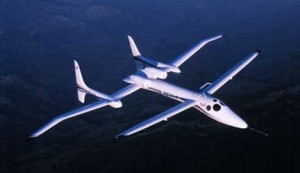Proteus visits for CLAMS
MADISON, WI, June 28, 2001—Almost yearly since 1997, an aircraft engaged in atmospheric research has visited Madison’s Truax Field, brought here by UW–Madison’s Space Science and Engineering Center (SSEC) and hosted by the 115 Fighter Wing, Wisconsin Air National Guard. This year a new plane graces Madison’s air lanes, the Proteus, a high-altitude long-duration instrument platform.
With its two sets of wings, the Proteus looks like a long skinny biplane. Its modular construction allows it to fly high or low in the atmosphere and carry different sizes of payloads in a pod under the aircraft. It can be flown with or without a pilot at the controls. It will be piloted when it comes to Madison.
To prepare for a field experiment called CLAMS, for Chesapeake Lighthouse and Aircraft Measurements for Satellites, on July 9 the Proteus will swoop in to retrieve a NASA instrument that was trucked to Madison for comparison tests with SSEC instruments. CLAMS takes place in July off the coast of Virginia Beach, Virginia. Primarily, the experiment seeks to refine the way current and future satellites measure aerosols and heat that Earth and sea reflect. It includes instrument teams from NASA, University of Washington and UW-Madison’s SSEC.
NASA’s NAST-I, for National Polar-orbiting Operational Environmental Satellite System (NPOESS) Airborne Sounder Testbed-Interferometer, is a flying testbed for future weather satellite instruments and is based at NASA’s Langley Research Center in Hampton, Virginia. William L. Smith, now Langley’s Director of Atmospheric Sciences, is NAST principal investigator. Smith originally directed design of SSEC’s interferometer-based suite of atmospheric research instruments. The design for the NAST-I follows from that of SSEC’s High-resolution Interferometer Sounder, used since the 1980s for research into Earth’s changing climate, focusing on temperature and water vapor structure of the atmosphere.
NPOESS is the next generation U.S. operational polar weather satellite system being implemented this decade. According to Allen M. Larar, deputy (Co-PI) for this project at Langley Research Center, “NAST is similar to the NPOESS, in that it consists of passive remote sensors, which measure the distribution of upwelling infrared (the NAST-I) and microwave (NAST-M) radiation emitted by the Earth’s surface and atmosphere with unprecedented spatial and spectral resolution.” Larar said that NAST data “simulate those to be achieved with the NPOESS as well those from instruments being developed to fly aboard other European polar orbiting and U.S. geosynchronous weather satellites to sense atmospheric temperature, water vapor, and other trace species with the spatial and temporal resolutions needed to advance weather and climate predictions.” NASA’s Integrated Program Office, which is responsible for developing NPOESS, is sponsoring this NAST measurement campaign. NAST data from this and other field experiments help reduce risk for NPOESS and other future space-based sensors.
Proteus was built by California’s Scaled Composites, Inc., and is based at their Mojave, California facility near NASA’s Dryden Flight Research Center, which is home to the ER-2, the NASA high-altitude plane most familiar to Wisconsin residents.
According to the National Guard’s Major David Olson, no public viewing opportunities are planned on base, but the Proteus is expected to arrive at noon on July 9 and leave in the early morning of July 10. Research aircraft generally use the North-South runway, which can be viewed from the Madison airport, or any nearby vantage point.
For more information, contact SSEC’s Public Information Officer, 608-263-3373.


